Minolta Miniflex
The Minolta Miniflex (ミノルタ・ミニフレックス) is a 4×4 TLR made in 1959 by Chiyoda Kōgaku Seikō, predecessor of Minolta. It appeared two years after the Rolleiflex Baby Grey, during the short revival of 127 film for the square format superslides.
Contents
Description
Film advance and back
The Minolta Miniflex can take twelve exposures in 4×4cm format. The film is advanced by a knob on the photographer's right, at the bottom, engraved with an arrow and the word WIND to indicate the turning direction. The film runs from the upper chamber to the lower chamber. This method reduces film distortion compared with the reverse travel direction,[1] and was adopted on the Minolta TLRs from the 1954 Minoltacord.
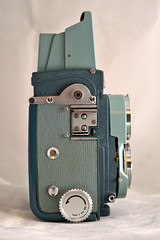 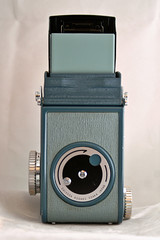
|
| Right side and back. Pictures by S. Montagna. (Image rights) |
 
|
| Body casting. (Image rights) |
The film advance automatically stops at each exposure and is unlocked when the shutter release is pressed. There is a round window on the advance side for an exposure counter. The position of the first exposure is set via a red window on the right of the back, protected by a large spring-loaded rotating disc, marked CHIYODA KOGAKU OSAKA JAPAN. Then the exposure counter is reset to "1" by pressing a button near the advance knob. This button is hidden in a slot and can be pressed with a fingernail or a coin; it has this shape to avoid accidental action.
The back is hinged to the top for film loading, and locked by a small rectangular key at the bottom. The tripod thread is integrated in the body casting and is not part of the back.
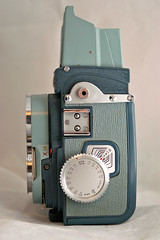
|
| Left side. Picture by S. Montagna. (Image rights) |
Focusing

|
| Focusing mechanism. (Image rights) |
There is a big focusing wheel on the photographer's left, turning 120 degrees and driving a heart-shaped cam moving the front standard back and forth. This wheel contains a film reminder, and there is an additional plate with depth-of-field indications. The distance scale is engraved either in metres or in feet, depending on the intended market. The minimum focusing distance is either 1m or 3.3ft.
The use of a bottom-driven focusing helix similar to that of the Minolta Autocord was considered during the development of the camera, but it was difficult to integrate with the rest of the mechanism, and raised design problems.[2] The feature was still studied in September 1959 for future developments,[2] but was of course abandoned when the 4×4cm format proved a market dead-end.
Viewfinder and top part
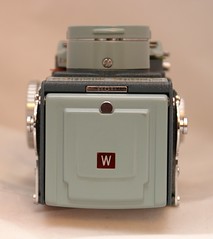 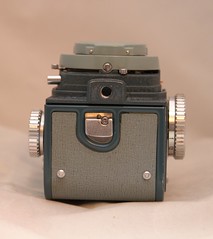
|
| Top and bottom. Pictures by S. Montagna. (Image rights) |
The viewfinder is integrated into the body casting, unlike most other TLR cameras. This construction allowed to reduce the cost of the viewfinder part.[3][4] The viewing hood has a peculiar three-fold, specially designed to avoid the side plates going deep into the body and to prevent the entry of dust.[4] It contains a square magnifying lens hinged to the top but no sportsfinder. It also has a logo at the front, showing the letter M in silver on a deep red background — at least some pre-production examples have a different logo with a lowercase m letter. The viewing screen contains a condenser for bright illumination of the corners.[3][2]
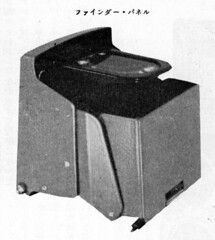 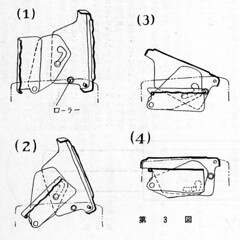
|
| Viewfinder assembly, from Shashin Kōgyō June and September 1959. (Image rights) |

|
| Strap attachments. (Image rights) |
The nameplate is made of translucent plastic, with the name minolta miniflex written in gold letters in the typical 1960s Minolta font. The body number is inscribed on a small metal strip above the nameplate. There are strap lugs on both sides of the body, for use with spring-loaded clamps on the strap itself. These strap attachments were specific to the Miniflex at the time it was introduced, but would be adopted on the Minolta Autocord from 1962.
There are two accessory shoes, one on each side, buried in the body casting in the space left free by the special viewfinder construction.[4] Each contains two spring-loaded spheres to hold the accessory on the shoe. The right-hand shoe has an indentation at the bottom, whose purpose is unknown. This shoe is used to attach the accessory sportsfinder (see below). Unlike most other TLR cameras, the Miniflex is held horizontally when using the sportsfinder.
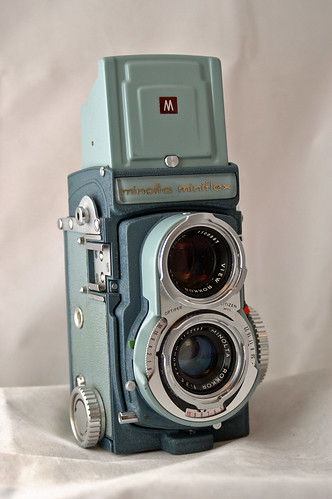 
|
| Minolta Miniflex, Rokkor 60mm f/3.5 taking lens no.1102785, View Rokkor 60mm f/2.8 viewing lens no.1100897. Pictures by S. Montagna. (Image rights) |
Shutter and lens
 
|
| Minolta Miniflex held in horizontal position. (Image rights) |
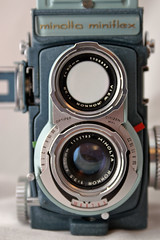
|
| Front face. Picture by S. Montagna. (Image rights) |
The shutter release is at the bottom of the front standard and protrudes towards the right; it was specially thought to make it comfortable to trip both in the vertical position and in the horizontal position.[5] The button contains a screw thread for a cable release.
The shutter is an Optiper Citizen MVL (B, 1–500). It is cocked by a small lever at the bottom. The self-timer lever is on the same side as the release button and is painted green. The opposite side has a red painted M/X selector and a PC synch socket. The shutter name is inscribed between the two lenses: OPTIPER on one side and CITIZEN MVL on the other.
The speed scale is on the left side, as seen from the front, and there is a Light-Value scale in a window below the taking lens. These two scales are inscribed on the same disc, moved by a lever placed near the release button. The aperture scale is engraved on a second disc placed above, and appears opposite the speed scale. This second disc is directly turned by hand, and has a small index moving along the Light-Value scale and indicating the Light-Value corresponding to the selected settings. The two discs move freely and are not interlocked, unlike other Light-Value systems.
  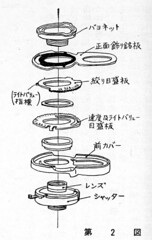
|
| Front assembly. From Shashin Kōgyō June and September 1959. (Image rights) |
The taking lens is a four-element[6][2] Minolta Rokkor 60mm f/3.5, and the viewing lens is a three-element[6] View Rokkor 60mm f/2.8. Both have a seven-digit serial number and a three-lug bayonet attachment. The attachment is physically the same as on the Minolta Autocord[6] but the spacing between the two lenses is reduced and the bayonet around the taking lens is upside down. As a consequence, the Miniflex can take all the filters made for Autocord, but needs a specific hood (see below).
Colour finish
The camera has two-tone blue finish: medium blue wrinkle finish paint for the body shell, back and moving front standard, and light blue lacquer for the viewing hood and the casing surrounding the lenses. Original documents from the company call the darker colour "greenish blue" and the lighter "silver grey".[7] The sides and the back have a matching blue-grey leatherette covering. With time, this leatherette covering tends to change colour and get a brownish tint on many examples.
Commercial life

|
| Announcement in Shashin Kōgyō May 1959. (Image rights) |
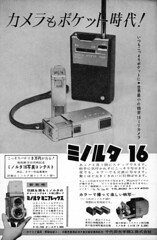
|
| Advertisement in Shashin Kōgyō November 1959. (Image rights) |
The Minolta Miniflex was announced in Japanese photography magazines dated May to July 1959.[8] The announcement in the May issue of Shashin Kōgyō says that the price and release date were "not fixed yet" (未定).[6] Two further articles in the June and September issues of the same magazine were written by Kubota Isamu, from the Chiyoda Kōgaku Seikō company.[9] Francesch says that the camera was released on September 23, 1959, but what this exactly means is unclear.[10]
The Miniflex was briefly advertised in Japanese magazines in October and November 1959.[11] The October advertisement in Camera Mainichi presents the camera along with the Minolta A3, and does not mention a price.[12] The November advertisement in Shashin Kōgyō, mainly devoted to the Minolta 16, makes some room for the Miniflex and indicates the price of ¥12,700 (case ¥1,800 extra).[13]

|

|

|

| ||
| Original leaflet in Japanese. Scans by A. Apra. (Image rights) | ||
Total production
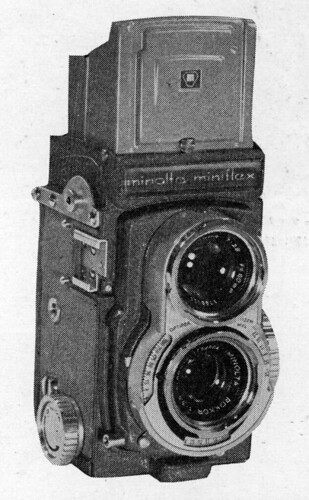 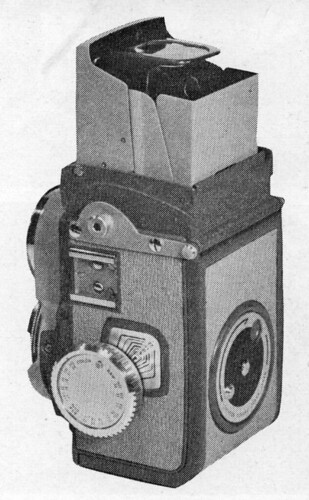
|
| Very early example, from Shashin Kōgyō June 1959. (Image rights) |
Body numbers are confirmed in the 100xxx, 102xxx, 103xxx, 104xxx and 105xxx ranges, and lens numbers are known in all thousands from 1100xxx to 1105xxx. The body, viewing lens and taking lens numbers usually do not match, sometimes by a wide margin.
The pictures reproduced above show an extremely early camera, differing from the regular production examples by the shape of the logo on the viewing hood.[14] Another picture in the September 1959 article in Shashin Kōgyō seems to show taking lens no.1100004 and perhaps viewing lens no.1100121, on a very early camera.[15]
The highest known numbers are body no.105258, taking lens no.1105178 and viewing lens no.1105049 (on different cameras). Various sources say that the production did not exceed 5,000,[16] but the available data seems to show that a few hundred more were made.
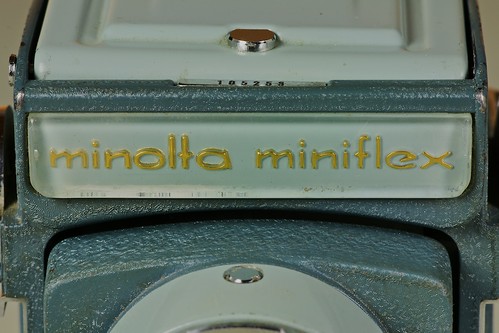
|
| Minolta Miniflex no.105258. Picture by Mikeladell. (Image rights) |
Accessories
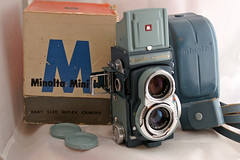 
|
| Minolta Miniflex with case, cap, auxiliary finder, case and original box. Pictures by S. Montagna. (Image rights) |

|
| Lens cap. (Image rights) |
Various accessories exist for the Minolta Miniflex. The camera usually comes with a leather ever-ready case and neckstrap, tinted in medium blue on the outer side; the case has the minolta logo at the front. The lens cap is light blue and has the same logo in front of the taking lens.
The metal lens hood was priced at ¥650.[17] It is medium blue with a silver base, containing the spring-loaded bayonet. It has a square shape, and has minolta at the top and the code D3B JAPAN at the bottom, both in white letters. It comes in a medium blue case with a triangular minolta logo. This accessory is specific to the Miniflex, which cannot take the hoods for the Minolta Autocord. It is attached to the outer bayonet, and physically fits the Autocord, but in the upside down position (with the minolta logo at the bottom).
The filters are shared with the Minolta Autocord, and are not specific to the Miniflex. The user manual of the Miniflex only mentions two filters called "control color" and "haze", probably corresponding to Y48 Yellow and UV, but others were made. The original brochure mentions the price of ¥380, but does not give a list of available filters.[17] The bayonet is sometimes described as 36mm diameter on the filters' original box, and some filters have the code F3B on the rim.
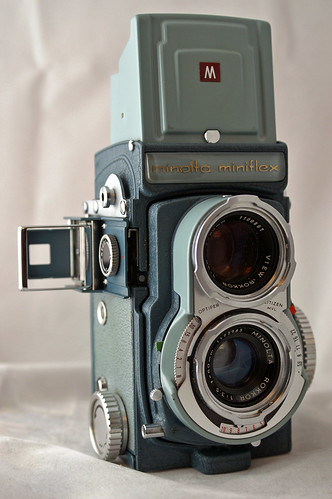 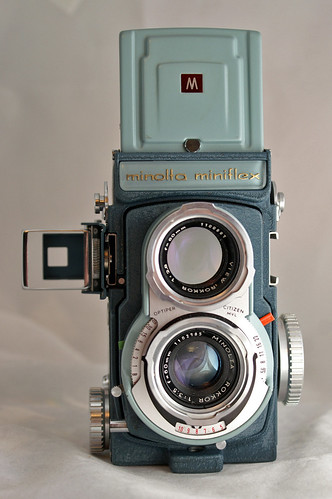
|
| Minolta Miniflex with external viewfinder attached. Pictures by S. Montagna. (Image rights) |
The external sportsfinder, of the folding frame type, is medium blue with a silver front frame, and comes in a small medium blue case. The finder has a locking knob inscribed L, O and JAPAN. It can be attached on any accessory shoe, but it is normally intended for use on the right-hand one.
The original box for the camera is red, white and grey, and has a big M in deep blue, shaped the same as on the viewing hood, and a big 44 among other markings.
 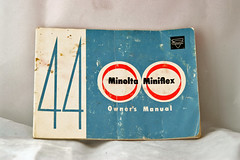
|
| Original box and user manual. Pictures by S. Montagna. (Image rights) |
The company was also selling 4×4cm "super slide" cardboard frames and the dedicated Minolta Mini 44 slide projector. It was sold for ¥6,800, including a vinyl case.[17] The BC Flash Gun with collapsible aluminium reflector was also offered for use with the Miniflex, at ¥1,700,[17] but it was not specific to the camera.

|
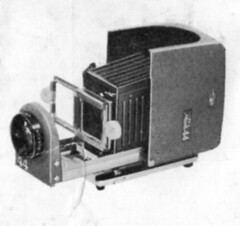
| |
| Minolta B-C flash gun, lens shade and filter. (Image rights) |
Minolta Mini 44 slide projector. (Image rights) |
Notes
- ↑ Kitano, pp.121–2 of the October 1955 special issue of Photo Art.
- ↑ 2.0 2.1 2.2 2.3 Kubota, p.273 of Shashin Kōgyō September 1959.
- ↑ 3.0 3.1 Kubota, p.639 of Shashin Kōgyō June 1959.
- ↑ 4.0 4.1 4.2 Kubota, p.272 of Shashin Kōgyō September 1959.
- ↑ Kubota, pp.638–9 of Shashin Kōgyō June 1959.
- ↑ 6.0 6.1 6.2 6.3 Column in Shashin Kōgyō May 1959, p.524.
- ↑ Kubota, p.639 of Shashin Kōgyō June 1959. The colours are called グリーニッシュブルー (濃い青緑) and シルバーグレー (青味がかった蠟色). Kokusan kamera no rekishi, p.407, wrongly says that these two colours correspond to two different versions of the Miniflex, certainly because of a confusion.
- ↑ Kokusan kamera no rekishi, p.407.
- ↑ Kubota, pp.638–9 of Shashin Kōgyō June 1959 and pp.272–3 of Shashin Kōgyō September 1959.
- ↑ Francesch, pp.39 and 101.
- ↑ Kokusan kamera no rekishi, p.407.
- ↑ Advertisement reproduced in Kokusan kamera no rekishi, p.304.
- ↑ Advertisement in Shashin Kōgyō November 1959, p.472.
- ↑ Pictures in Kubota, p.638 of Shashin Kōgyō June 1959.
- ↑ Picture in Kubota, p.273 of Shashin Kōgyō September 1959.
- ↑ This page at Pacific Rim Camera, this page of Aya's Camera Site, this page at Manual Minolta.
- ↑ 17.0 17.1 17.2 17.3 Leaflet Minolta–Miniflex 44, c.1959.
Bibliography
Original documents
- Chiyoda Kōgaku Seikō. Minolta–Miniflex 44. Leaflet published c.1959 (date not indicated). Document reproduced in this Flickr album by Rebollo_fr.
- Chiyoda Kōgaku Seikō. Minolta Miniflex 44 Owner's Manual. Document reproduced in this Flickr album by Rebollo_fr.
       
|
       
|
       
|
| Minolta Miniflex owner's manual in English. Scans by S. Montagna. (Image rights) |
- Kitano Kunio (北野邦雄). "Bodi kankei no sho-kikō (2): nigan-refurekkusu ni okeru firumu no makitori hōkō" (ボディ関係の諸機構[2]二眼レフレックスに於けるフィルムの巻取方向, "Various mechanisms for the bodies [2]: film advance direction on twin lens reflex"). In Photo Art rinji zōkan: Kamera no chishiki (フォトアート臨時増刊・カメラの知識, Photo Art special issue: Knowledge of cameras). October 1955, no.87 of the magazine. Pp.121–2. (This is an article on the direction of film advance on TLR cameras, which gives no specific information on the Miniflex.)
- Kubota Isamu (久保田勇), from the technical department (技術部) of Chiyoda Kōgaku Seikō. "Minoruta Minifurekkusu" (ミノルタミニフレックス, Minolta Miniflex). In Shashin Kōgyō no.86, June 1959. Pp.638–9.
- Kubota Isamu (久保田勇), from the technical department (技術部) of Chiyoda Kōgaku Seikō. "Futatsu no 44 kamera kikō to sono tokuchō: Minoruta Minifurekkusu" (二つの44カメラ・構造とその特長・ミノルタ・ミニフレックス, Construction and vantages of two 4×4 cameras: Minolta Miniflex). In Shashin Kōgyō no.89, September 1959. Pp.272–3.
- Shashin Kōgyō no.85, May 1959. "Shinseihin Minoruta Minifurekkusu" (新製品・ミノルタ・ミニフレックス, New product: Minolta Miniflex). P.524.
- Shashin Kōgyō no.91, November 1959. Advertisement by Chiyoda Kōgaku Seikō on p.472.
Recent sources
- Asahi Camera (アサヒカメラ) editorial staff. Shōwa 10–40nen kōkoku ni miru kokusan kamera no rekishi (昭和10–40年広告にみる国産カメラの歴史, Japanese camera history as seen in advertisements, 1935–1965). Tokyo: Asahi Shinbunsha, 1994. ISBN 4-02-330312-7. Item 1653.
- Francesch, Dominique and Jean-Paul. Histoire de l'appareil photographique Minolta de 1929 à 1985. Paris: Dessain et Tolra, 1985. ISBN 2-249-27685-4. Pp.39–40 and 100–1.
- Lewis, Gordon, ed. The History of the Japanese Camera. Rochester, N.Y.: George Eastman House, International Museum of Photography & Film, 1991. ISBN 0-935398-17-1 (paper), 0-935398-16-3 (hard). P.98.
- McKeown, James M. and Joan C. McKeown's Price Guide to Antique and Classic Cameras, 12th Edition, 2005-2006. USA, Centennial Photo Service, 2004. ISBN 0-931838-40-1 (hardcover). ISBN 0-931838-41-X (softcover). P.681.
- Scheibel, Anni Rita and Joseph. 70 Jahre Minolta Kameratechnik — Von der Nifcalette bis zur Dynax 9. Stuttgart: Lindemanns Verlag, 3rd edition, 1999. ISBN 3-89506-191-3. Pp.50–1.
- Sugiyama, Kōichi (杉山浩一); Naoi, Hiroaki (直井浩明); Bullock, John R. The Collector's Guide to Japanese Cameras. 国産カメラ図鑑 (Kokusan kamera zukan). Tokyo: Asahi Sonorama, 1985. ISBN 4-257-03187-5. Item 2196.
- Tanaka Masao (田中政雄). "Minolta Camera: nigan-refu kamera" (Minolta Camera: 二眼レフカメラ, Minolta TLR cameras). Kamera Rebyū: Kurashikku Kamera Senka (カメラレビュー クラシックカメラ専科) / Camera Review: All about Historical Cameras no.12, October 1988. No ISBN number. Minoruta kamera no subete (ミノルタカメラのすべて, special issue on Minolta). Pp.25–30.
- Watakushi no ni-gan-refu kamera-ten (私の二眼レフカメラ展, Exhibition of twin lens reflex cameras). Tokyo: JCII Camera Museum, 1992. (Exhibition catalogue, no ISBN number.) P.20.
- Zaisu Ikon (座椅子遺恨, probably a pseudonym of Y. Saji). "Besuto sanka (M–O)" (ベスト讃歌[M–O], Vest hymn [M–O]). In Camera Collectors' News no.63 (September 1982). Nishinomiya: Camera Collectors News-sha. P.4. (Gives a brief description and a picture; the pictured camera is presumably the same as in Sugiyama.)
Links
In English:
- Minolta Miniflex user manual at Flickr Camerawiki
- Miniflex at Pacific Rim Camera
- Miniflex at Cameras Downunder
- Past sales by Westlicht Photographica Auction (now Leitz Photographica Auction):
- Miniflex serial no 102142, lot no.693 of the eighth auction, 27 November 2005 (this particular example has no accessory shoe on the photographer's left, for some reason)
- Miniflex serial no. 104145, lot no.781 of the fifteenth auction, 23 May 2009
- Past sales by LP Foto:
- Miniflex, lot no.701 of auction no.17 (7 December 2002)
- Miniflex, lot no.74 of auction no.26 (22 April 2007)
In Japanese:
- Miniflex at Aya's website
- Pages at Asacame (Homepage archived at archive.org May 2019):
- Miniflex in the A-Z 127 film cameras
- Miniflex, Walz Automat 44 and Primo Jr
- Japanese 4×4 TLRs, including the Miniflex
